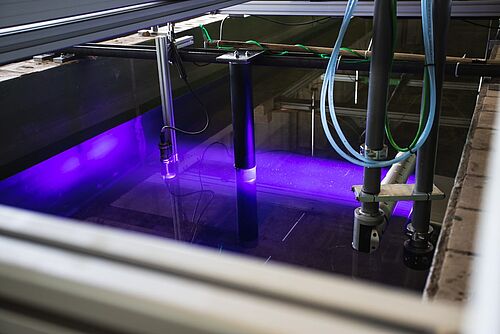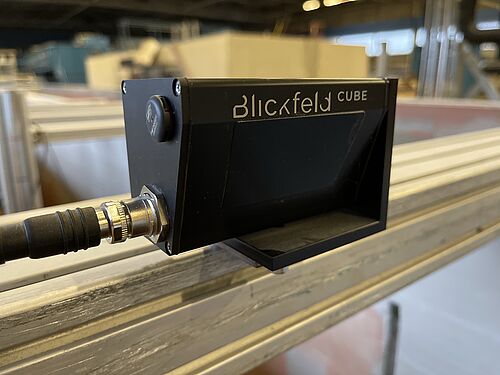Measurement technology plays a central role in hydraulic testing in order to record, store and analyse data precisely and reliably. The available measurement technology includes a variety of data acquisition systems and measuring instruments that are used to measure parameters such as water level deflections, velocities, pressure, forces, movements and other important variables in hydraulic systems. These measurements are essential for the basic and practice-orientated research that takes place in our test hall and serve as a basis for understanding processes, developing new methods or for practical tasks.

The submerged Particle Tracking Velocimetry (PTV) system from LaVision with an underwater minishaker is a special measuring instrument. To ensure safe operation, the tracer particles used are illuminated by an LED. This measuring instrument is used to accurately measure flow velocities in fluids and combines powerful PTV technology with the innovative "shake-the-box" approach to deliver accurate and reliable results.
LaVision's system uses high-resolution cameras and specialised image processing algorithms to record the movement of particles in the flow. By tracking these particles, the system can provide highly accurate information about velocity fields, turbulence and flow patterns. The cameras provide the particle movements in a volume of approximately 300 x 200 x 150 mm with a maximum recording frequency of 500 frames per second.
This special approach provides us with a powerful measuring instrument for analysing complex flow phenomena and gaining an in-depth understanding of various fluid systems.

In hydraulic testing, laser scanners enable the collection of large-area data with high precision and speed. In addition to large-scale individual measurements using laser scanners, the data can also be processed and saved directly using innovative LiDAR scanners. This benefits investigations into sediment displacement and the resulting bed profiles.
With our wave gauges, we are able to measure the surface deflection of the water or the wave run-up or overflow. Two measurement techniques are used for this: resistance wire gauges, which directly measure the water level deflection due to the voltage drop between the electrodes caused by the surrounding water, and ultrasonic wave gauges, which measure the water level deflection based on the reflected ultrasound.
We use electromagnetic (see image), acoustic and mechanical velocity sensors to measure flow velocities. Depending on the measurement task, different measurement techniques can be selected as required.
In electromagnetic measurement, flow velocities are recorded in two directional components based on the induction principle (Faraday's law). A magnetic field is generated at the sensors, which can measure the flow in the surrounding water through the generated voltage. With acoustic measurement technology, we are able to map three-dimensional flow velocities. This can also be done under turbulent conditions, whereby typical areas of application here are, for example, investigations of the surf zone, turbulence measurements or the combined recording of waves and currents. The mechanical measurement is carried out using impeller probes that record the flow. This method is very simple in design, but the flow velocities can only be measured in terms of magnitude, which means that the direction of flow is not taken into account.
![Kraftmesser auf Profil [Translate to English:] Kraftmesser auf Profil](/fileadmin/_processed_/1/c/csm_Druckmesser_auf_Profil_1d691b29e4.jpeg)
Force and torque sensors can be used to measure wave-induced forces on structures, for example. Elastic deformations are used to record forces and moments in all spatial directions. Sensors of different sizes, measuring ranges and accuracies are available, which are selected depending on the measuring task.
Vacancies of TU Braunschweig
Career Service' Job Exchange
Merchandising
Term Dates
Courses
Degree Programmes
Information for Freshman
TUCard
Technische Universität Braunschweig
Universitätsplatz 2
38106 Braunschweig
P. O. Box: 38092 Braunschweig
GERMANY
Phone: +49 (0) 531 391-0
